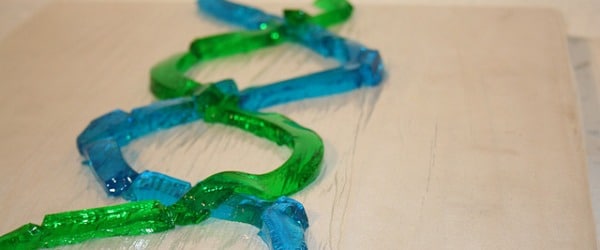Gel Electro-For-Whatsit? Breaking Down How Gel Electrophoresis Works

Run to red! It’s a mantra I learned when first using gel electrophoresis to separate DNA molecules. This can save you a lot of frustration and humiliation in the lab (stage right: a complaining scientist who swears the equipment is broken as a supervisor facepalms in embarrassment). But what about how does this jell-o like stuff really work?
The concept sounds simple: standard gel electrophoresis uses an electric field to separate macromolecules, like DNA, RNA, proteins and nanoparticles, based on their size (as long as they are traveling in the right direction – hence the mantra)! Two-dimensional gel electrophoresis separates proteins based on size and isoelectric point, but that’s a discussion for another article.
Gel electrophoresis, like many techniques, is perceived to be simple but is more complicated than it seems. However, let me be your enzyme and break it down!
The gel does more than act like a sieve
The main purpose of the gel is to separate proteins based on size. The gel provides a resistance as molecules are pushed through it. The resistance is like stirring a cup of coffee with a wooden coffee stirrer compared to a large spoon; the wooden stirrer travels more times around the cup than the large spoon does given the same amount of energy expended moving them. (The appearance of analogies like this makes me realize that it’s coming up to caffeine time for me!)
The most commonly used gels are composed of agarose or polyacrylamide (a mixture of acrylamide and bis-acrylamide). You can change the percentage of agarose or ratio of acrylamide/bis-acrylamide to increase or decrease the resistance of the gel and provide better resolution for differently sized molecules.
The gel type you need is based on the properties of your samples. Agarose gels are usually used for separation of DNA and RNA, unless high resolution is required. Polyacrylamide gels are typically used to separate proteins. They can also be used to resolve very small nucleic acids.
In addition to separating molecules based on size, the gel matrix also acts as an anti-convector by suppressing thermal convection from the electrodes. This means that your proteins don’t get cooked with heat from the electric current (this is a gel, not a stir fry). Finally, the gel acts as a solid support when you use dyes to stain and visualize your samples.
Size matters
Gels are like size fractionators – smaller molecules pass through the gel more quickly than larger ones, separating molecules based on their size.
The conformation of the macromolecule also plays a role. A big blob of folded protein or a supercoiled plasmid will travel differently through a gel than an unwound linear strand. Thus, double-stranded DNA samples need to be linearized if they are to be accurately separated by size. Alternatively, formamide and urea can be used to denature DNA and RNA samples. Likewise, you treat proteins with a detergent to denature the proteins prior to electrophoresis.
Negate the charge
When you hook your electrodes up to the gel apparatus and turn it on, an induced electric field pulls the molecules from one side of gel to the other. The “pulling” energy is created by the positive electrode at the end of the gel and is complemented by the “pushing” force created by the negative electrode.
The electrodes pull and push more negatively charged molecules through the gel more quickly and so care must be taken to ensure a uniform charge to mass ratios of all samples in the gel. This is one of the reasons you add sodium dodecyl sulfate (SDS) to your proteins prior to electrophoresis; the SDS coats proteins in a negative charge so that they are only separated according to size, and not charge.
So there you have it! The breakdown: a gel is more than just jell-o and your samples need to be linear before they are pushed around to determine their size.
However, I would like to recommend that you stick to jell-o as a marvelous after dinner snack.
2 Comments
Leave a Comment
You must be logged in to post a comment.
[…] already gone through the basics of how gel electrophoresis work, compared common gel types like agarose and polyacrylamide and even explored some alternatives. Now […]
[…] biochemists, we routinely run SDS-PAGE to analyze our proteins. It can be a repetitive and tedious task to get a “presentable” gel for […]